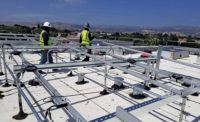One of the largest distributed commercial solar retrofit projects in California required creative planning, design and logistics. In April, Sacramento-based HMH Builders completed the first of 15 1 MW photovoltaic additions to health provider Kaiser Permanente buildings up and down the state as part of an Engineering, Procurement and Construction agreement with San Francisco-based solar developer Recurrent Energy.
Because the first application was on the 400,000-sq-ft rooftop of a regional distribution center in windy Livermore where gusts can reach 115 mph, HMH switched from a planned ballasted design that used weights to anchor photovoltaic trays to a connected system. Steel frames were attached directly to the roof support without interrupting operations in the working facility. HMH removed 1-ft by 2-ft by 10-in. sections of Cellcrete roofing to attach 670 individually-mitered block-and-post assemblies. “Each block had to be individually cut to match the compound slope of the roof so the frame fit flush to the roof and maintained a 20% tilt for optimum solar radiation collection performance,” said HMH Solar Project Manager Kevin Kaaneh.
The three-and-a-half month-long construction project was carefully orchestrated to work around the trucks that loaded on a 24/7 schedule. Crane picks were timed so that when a truck left a bay, a prefabricated module could be lifted into place and the crane removed before the next truck arrived a half-hour later.
At a Santa Clara site where new solar roofs are being added to two parking garages, contractors are using ground-penetrating radar and Ferro scans to determine the optimal placement of threaded anchor bolts. The existing posts are already crowded with tensioning cable and bolts that can’t be touched.
No new posts could be added because parking was at a premium and no space could be lost to new support structures. In fact, temporary valet parking is instituted whenever construction impedes any parking spaces so patients can get to their appointments quickly. The scans allow contractors to pick the safe places to chord holes to attached the elevated steel frames for the photovoltaic roof.
Recurrent Energy will own the solar arrays and has a 20-year power-purchase agreement to sell power back to Kaiser Permanente at the same price or less than it would have cost to purchase the power from local utilities. Other locations to receive the solar retrofits include Vallejo, Fontana and San Diego medical centers. The locations were chosen in part based on whether local utilities offered solar incentives. Incentives combined with bulk pricing for materials reduced the construction costs to less than $4 a watt, reported HMH Builders Operations Manager Bryan Holt.
With help from parent company Swinerton Inc., San Francisco, the entire project is scheduled for completion by the end of 2011. When complete, these projects will supply 10% of the power used by the 15 facilities. The goal is to have 25% of its energy needs met by alternative power by 2020. That could take the form of solar, fuel cell, heat pumps and/or cogeneration.
An RFP for a Power Purchase Agreement to extend solar to other Kaiser Permanente facilities in the rest of the country could be released in the first quarter of 2011, said Jeffrey Keyak, senior energy consultant for Kaiser Permanente.


Post a comment to this article
Report Abusive Comment